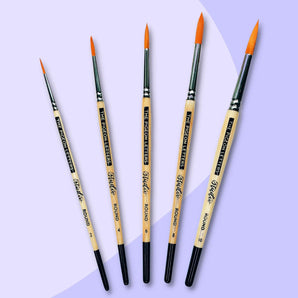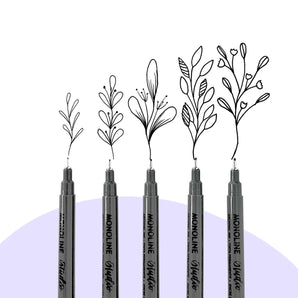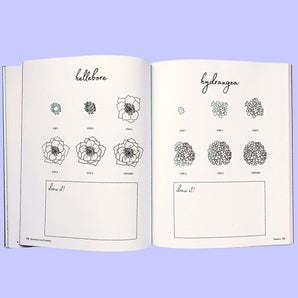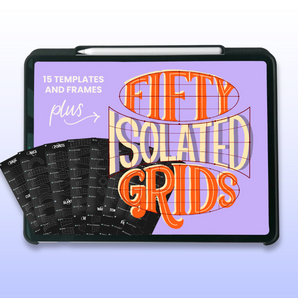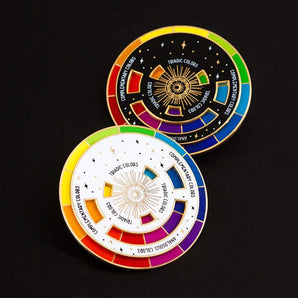I'm going to walk you through how to paint vintage wildflowers using wet-on-wet watercolor techniques. It's time to loosen up and letting your brush run wild and to work with beautifully curated colors that celebrate an antiqued aesthetic.
For those who prefer video walk-throughs, you know I've got ya covered! Below the painting video tutorial, you'll find all of the steps broken down in written form. Let's get started!
Materials Needed
- Watercolors - While I'm mixing colors in this tutorial, I'm primarily grabbing this beige (my FAVORITE paint color - I use this in almost all of my paintings!), this blue, and this cool green alongside this deep green.
- Round paintbrush (small size)
- Filbert paintbrush
- Watercolor paper - Because we'll be using wet-on-wet techniques, it's best to use paper that is specific to watercolor. This is my favorite watercolor paper, but you can use anything that is labeled 140lb/300gsm.
- Jar of water

Grab my custom Daniel Smith dot chart featuring my favorite colors here.
Step 1: Paint the Top of the Flowers

Begin your piece by painting the top of the flowers on the top half of your paper.
I like to use a filbert brush and start off with a light, transparent neutral, such as a light beige color mixed with more water than paint. It sets you up for additional colors you'll add in later.
Filbert brushes work to our advantage when we're painting oblong shapes. Using medium-to-full pressure on the flat side of your brush, pull a small c-curve on each side, creating an oblong shape.
Then repeat this stroke combination at staggering positions to bundle stalks together.
Step 2: Use Wet-on-Wet Inside the Flower Shapes

While your base shapes are still wet, grab a second color and tap your brush gently inside near the edges.
To spice things up, I grabbed an unlikely blue to bring in a pop of color on the bottom edge of my flower shapes. Keep this added color to one side only. You'll be adding more to the other side in the next step.

Note: While it will be tempting to push this color around, DON'T! At least not yet.
Allow the paint to do its thing. When you add paint to an area that is already wet, it will naturally bleed to other areas. When you let it do what it wants, you'll render beautiful results. (If after a few minutes, you notice that it needs a little encouraging push, you can do so gently.)
Step 3: Add More Pigment

While your flower shapes are still wet, grab more pigment from the first color you used to paint your base shapes.
Dab your brush at the opposite end toward the edges to create another wet-on-wet effect.
It will appear much deeper since your base shapes were so transparent. This combination adds beautiful depth to what would have otherwise been bland shapes.
Pro tip: If you notice that your base shapes have dried by now, you won't get the exact same effect, but it's not too late! You can wet your brush and paint over the shape with water only, then go back in to this step.
Step 4: Paint Leaves at the Base of Your Flower

Using a round brush now, paint some straight, stiff leaves at the base of your shapes.
You can do this by using more pressure where the leaves connect with the flower and less pressure at the ends, which will create a fine, spiky tip.
I'm using a rich, deep green color. You can get creative and go for brown, cream, or even violet!
If your base is still wet, you'll see some of that wet-on-wet bleed that we love oh so much. I'm always a fan of this effect when stems and leaves connect. It's totally optional, so if your flower base shapes have already dried by this point, no problem!
Step 5: Paint Organic Wildflower Stems

To paint organic wildflower stems, loosen your grip on your brush and lightly drag your brush to connect to the base of your flowers.
Play with a light touch, creating a thin stem, then apply a little pressure to vary thickness in your stroke. I paint my stems using varied pressure throughout the whole stroke. It's fun to explore creating intentional wobbles in your stems.
Step 6: Paint Wildflower Leaves

Use the lightest pressure and the tip of your round paintbrush to drag a smaller stroke off of one of your main stems.
I recommend beginning your paint stroke from the stem, dragging it up and off the stem. That way, it travels in the natural growth direction and won't look oddly attached.
Additionally, it can be fun to add a couple different hues of green. In my piece, I rotated between a deep green and a softer, less pigmented cool green.

After you paint the stem, you'll paint organic leaves that connect.
You can paint leaves in one easy stroke. Use the side of your brush and apply pressure. Slowly drag your brush as you release pressure in the same motion. Once you get to the end of your leaf, you should be at the lightest pressure.
With practice painting leaves, this motion gets very easy. I recommend my easy tutorial on painting elegant leaves to get comfortable with this muscle memory.
Step 7: Add Texture to Your Thistles

Using the tip of your brush, gently tap your brush to create tiny marks toward the top of your flower shapes.
Sometimes I'll even create tiny horseshoe shapes to make it look like there's a bit of bumpier texture.
Pro tip: You don't want to add too many of these marks! If you add too much detail to a loose floral piece, it will look unbalanced and unfinished. So remember to stop before you're ready!

And just like that, you've completed your beautiful thistle wildflower piece!
This tutorial is a part of my 14 Days of Painting Prompts featuring Vintage Wildflowers in Watercolor, which you can watch on Skillshare!
If you're not a current member, this link will unlock a month for free and you can cancel any time. And you WON'T be disappointed.
This class is one of my most engaged classes, filled with creative people who love a good challenge! But don't take my word for it...

Head over and start the challenge now!
Check out similar blogs:
Pin this tutorial for later!













